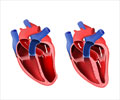How the Exercise Stress Test Is Performed
The patient is asked to walk on a treadmill or pedal a stationary bike at increasing levels of difficulty.
Meanwhile electrocardiogram (
Baseline heart rate and blood pressure are measured before the test. Electrodes are placed on the chest to record the heart’s electrical activity. The blood pressure cuff on the arm is inflated every few minutes. It is normal for the heart rate, blood pressure, breathing rate, and perspiration to increase during the test. The patient has to report any unusual symptom like chest, arm, or jaw pain or discomfort, shortness of breath, dizziness, light-headedness.
The test is continued till:
- A target heart rate is reached
- The patient develops complications like chest pain, abnormal changes in blood pressure (rise or drop)
- ECG changes show that the heart muscles are not getting sufficient oxygen
The patient is monitored for another 10-15 minutes, or until the heart rate returns to normal.






